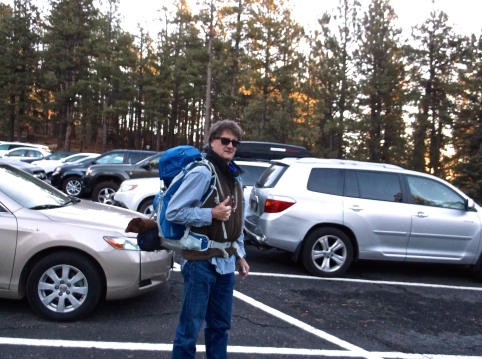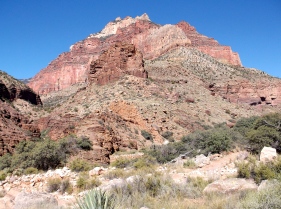Occasionally in my adult life, I have taken off on random adventures, some long, some short. In high school, during a teacher’s strike, two friends and I stuck out our thumbs at the bottom of Loveland Pass, heading for Salt Lake City and who knows what.
A few years later, after successfully completing a brief, court-ordered probation, I headed west by thumb again, sleeping one night on Huntington Beach, and another in a street mission where the price of a bed was a sermon. One year I rode a bicycle from Eugene, Oregon to Los Angeles, all along the Pacific Coast.
Months after involuntarily ending a management career, without a paycheck for the first time in 18 years, I took off for Europe, and rambled around by train for several months, lost then found.
The list goes on, as lists do. These adventures usually begin as neurological glimmers, as though a new synaptic branch opens up, compelled by possibility and waiting for fruition. I don’t understand why they come, or how. I just do them. On top of bragging rights, I am certain that all of these exciting, risky, and unusual happenings serve as trials or tests – necessary, mostly difficult experiences with indeterminate origins and lifelong impact. That history is what led me, I think, to attempt a rim-to-rim Grand Canyon hike.
GETTING THERE
I can recommend driving in to the north rim from Kanab, Utah, early in the morning. The darkness is plenary, as absolute as when eyes are closed. The only source of illumination is the reflection of headlights from yellow paint dividing the narrow asphalt on Arizona Highway 67. Unseen dark forests line the twisting path. FM radio signals from Las Vegas and Phoenix are chased, briefly captured, then released by the seek button. The only visible landmarks for a first-time traveller are small clusters of hesitant deer waiting patiently to safely cross the road, frozen as the car passes them by. In a mile or two, or five or ten, pickup trucks pulled safely from the roadway mark bowhunter territory, camouflaged archers waiting patiently for the deer. Three days from now, on the early afternoon return to Kanab, dozens of roadside signs, buildings, campgrounds, and other easily seen and expected markers line the entrance road, and give confidence to an illusion of 21st-century civilization. On this predawn October morning, it’s a 60-mile-per-hour tunnel ride, an unfamiliar path to a wild undertaking.

TRAILHEAD
The trailhead parking lot is busy. Car doors slam, voices chirp and chatter. There’s a line for the toilet. Only one man seems prepared for an epic voyage, sporting a loaded backpack and well-worn Danner hiking boots. Pictures of excited groups are sent away through Instagram. Tweets and Snapchats are hastily thumbed as reminders to fill water containers, along with muffled cautions like “Be safe.”


On the North Kaibab trail, it’s immediately clear that scrawny, dedicated walkers and trail runners outnumber trans-canyon overnight travellers. Within the first mile of my descent, 1,000 feet lower than where I started, I had already been passed by numerous trekkers, wearing Camelbaks, expensive off-road trail running shoes, and wielding aluminum hiking poles with facilty and skill. Many passed heading up to the trailhead. It’s 7:30 AM and these lanky maniacs are on the tail end of a 7-mile, 4,000-foot climb. I’m only unique in my bulky accoutrement, my thrift store wardrobe, and my prescription Ray-Ban Wayfarers.
Trail-runners are a consistent and amazing feature during the entire hike. It was easy to hear them coming form either direction, a distinctive scrape of steel-tipped poles against rocks in the trail, soft impact of soles in dirt, and an amazing amount of conversation, given the supposed exertion. I’m not sure, but I think I even saw 4 or 5 pounding their way past Cottonwood Campground at 1:00 in the morning.

COTTONWOOD CAMPGROUND

After 5.5 hours, 6 miles, and a 4,000-foot descent, I limped into Cottonwood, exhausted, hungry, and ready to stop walking. I was so tired I bounced from chore to chore; ate a bite, sipped some water, take an item from my pack, lay on the picnic table, then repeat the entire cycle. Tired, not sleepy. The contents of the pack, those select necessities that had been fucking with my center of gravity all day, look impossibly weight-free strewn out on the table. The back of my shirts stayed wet with sweat for several hours. Rubber-legged and panting an hour later, my position in site #1 let me sit and watch others go by, my breathing slowly normalizing even as I recognized some trail runners who had passed me going down, and realized they were heading back to the top.


Reviewing my performance for the day, I was glad I went slowly and took my time. A 4,000-foot descent may sound easy, but other factors made the day’s 6-mile distance difficult. In many places the scree on the trail caused me to slide and grab for support, and most of the time the weight of my pack pulled me around at will, making a challenging trek even more challenging.
I decided to dump 3 liters of water. I consumed 2 liters so far. I knew tomorrow’s distance would be easier, and I was willing to cut weight any way I could. Completely unpacked, then repacked the next morning with a new distribution scheme i hoped would help with my center-of-gravity issues.
One hour after sundown I was comfortably zipped into the bivy bag. Next thing I knew, the sun was coming up – ten hours later.



HOW LONG?
Bright Angel Campground arrived after only 3.5 hours on the trail. Same basic distance, 7 miles, as all three sections of a rim-to-rim hike, but a descent of only 1500 feet over the day’s journey means less fatigue and a more stable pace. Less weight, perfect weight distribution, great weather and a well-rested traveller = at the destination by 1:00 PM.

So, there’s lots of time to explore, contemplate, and discover the lowest point of the Grand Canyon on this route.
Bright Angel Canyon is relatively narrow and not the vast, majestic experience of the long, deep, and wide multi-millenial water erosion attributed to the Colorado River. Further along the trail, some of the more expected, stereotypical views of “THE Grand Canyon” can be seen


Relief and wonder drive the Bright Angel Campground vibe. The Phantom Ranch development is a little startling – walking by the well-maintained cabins, canteen, and a large construction project after two days winding among the desert shrubs and sheer stone canyon.

Lots of hikers, runners, construction workers, drill and generator noises, mules loaded with packs and wealthy tourists, and park rangers occupy this busy divergence. Down along the river, rafts and river travellers fill the boat beach.


Anticipation of tomorrow’s voyage keeps me awake most of the night, along with bright illumination from a full moon. I can only think about what has to be accomplished Monday in the abstract, though I know the numbers that make it real. 6.9 miles and a 4,700-foor ascent. Going up is part of EVERY Grand Canyon journey, and the way home is at the end.
RISE TO THE TOP

Panting and resting are two dominant actions today. There’s no viable alternative, no escape plan, no choice but to make it to the top in order to begin the trek home.
The trail is busy, much busier than either section so far. Mules, trail runners, eventually hikers descending from the South Rim, my only goal for the day. Being able to accurately predict the flood of relief and satisfaction connoted by completion of today’s path would be cool, and probably motivational. I just try to keep going, stopping as often as necessary, looking back at a voyage that grew more and more amazing the higher I climbed. Mutual encouragement and friendly, sincere support between everyone on the trail is epidemic. At one of my innumerable rest stops, a downhill group of young men noticed the “Get Lost (in Montana)” sticker on my water bottle, so we talked about Bozeman, Missoula, and Glacier National Park.
Near the top, and near the end of my stamina after several hours of tortuous, incessant climbing, I met young Jacob and his parents. I didn’t know it at the time, but the end was less than two miles away. Jacob’s mom and dad challenged him with multiplication tables and arithmetic problems to keep him going up the trail to the top, where they had started around an hour earlier. Jacob whined occasionally, and I empathized with him (not aloud). Eventually, finally, we all got to the South Kaibab trailhead. A few stories were exchanged – turns out the young fam came from Colorado. Their amazement, and Jacob’s nonchalant curiosity, made me feel like a hero for doing the rim-to-rim. By the time I make it to Mather Campground, via the park’s requisite shuttle buses, many people connect the grimy appearance, the glazed, oxygen-starved countenance, and the bulky pack with a capital “J” journey. On the Blue bus, the couple nearest me asked the right questions then announced to the entire, nearly-full transport, “This man just finished walking from the North Rim.” No one on the bus looked as though they had seen more than the views from inside the shuttle.




AFTER
I didn’t really consider the endeavor as an entire, complete thing until I finally got back to Fort Collins. Unpacked and unwound, the rim-to-rim is a concise, complete unit, an adventure to add to the list, one for the books, and so on. The impact of what I had done suddenly grew into lightning flashes of endorphins and ego. Time will wear down the sharper edges of the past few days, and when the story is told, the spikes caused by accomplishment and endurance will become more humble, easier to communicate. The one word I will use to describe the experience, mostly to myself, will be:


